Transtek Medical Electronics TMB995-BT Blood Pressure Monitor User Manual
Guangdong Transtek Medical Electronics Co.,Ltd Blood Pressure Monitor Users Manual
Users Manual
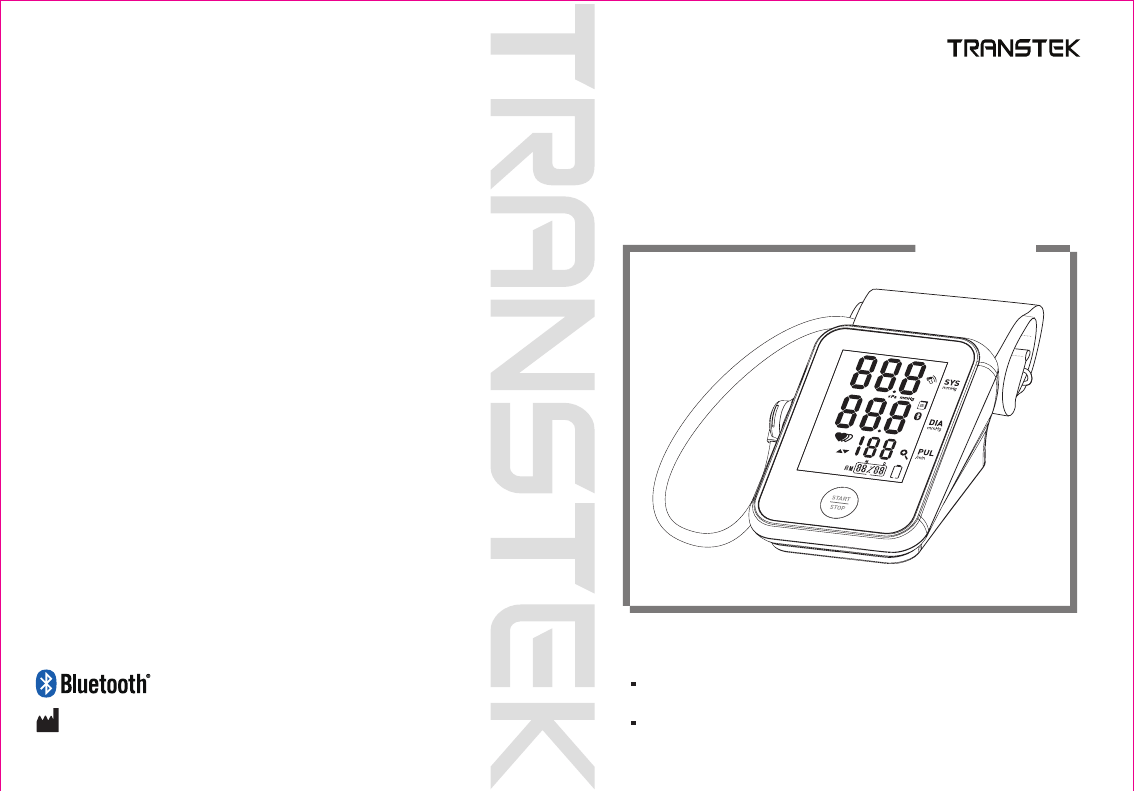
version:1.0
User Manual
Blood Pressure Monitor TMB-995-BT
Arm Type
Thank you very much for selecting TRANSTEK Blood Pressure Monitor
TMB-995-BT.
Please do read the user manual carefully and thoroughtly so as to ensure the
safe usage of this product, and keep the manual well for further reference in
case you have problems.
Guangdong Transtek Medical Electronics Co., Ltd.
Zone A, No.105 ,Dongli Road, Torch Development District,
Zhongshan,528437,Guangdong,China

Table of Contents
INTRODUCTION...................................................................................................................2
General Description
Indications for Use
Contraindications
Measurement Method
Safety Information
LCD Display
Monitor Components
List
BEFORE YOU START...........................................................................................................9
Power Supply
Installing and Replacing the Batteries
MEASUREMENT...................................................................................................................10
Tie the Cuff
Start the Measurement
DATA MANAGEMENT..........................................................................................................12
Recall the records
Pair up the Blood Pressure Monitor with Your Device
Data Transmission
INFORMATION FOR USER................................................................................................ 15
Tips for measurement
Maintenances
ABOUT BLOOD PRESSURE..............................................................................................17
What are systolic pressure and diastolic pressure?
What is the standard blood pressure classification?
Why does my blood pressure fluctuate throughout the day?
Why do I get a different blood pressure at home compared to the hospital?
Is the result the same if measuring on the right arm?
TROUBLESHOOTING........................................................................................................19
SPECIFICATIONS...............................................................................................................20
AUTHORIZED COMPONENT ............................................................................................21
CONTACT INFORMATION..................... ...........................................................................21
COMPLIED STANDARDS LIST...........................................................................................22
FCC STATEMENT................................................................................................................23
EMC GUIDANCE.................................................................................................................24
1
CATALOGUE CATALOGUE
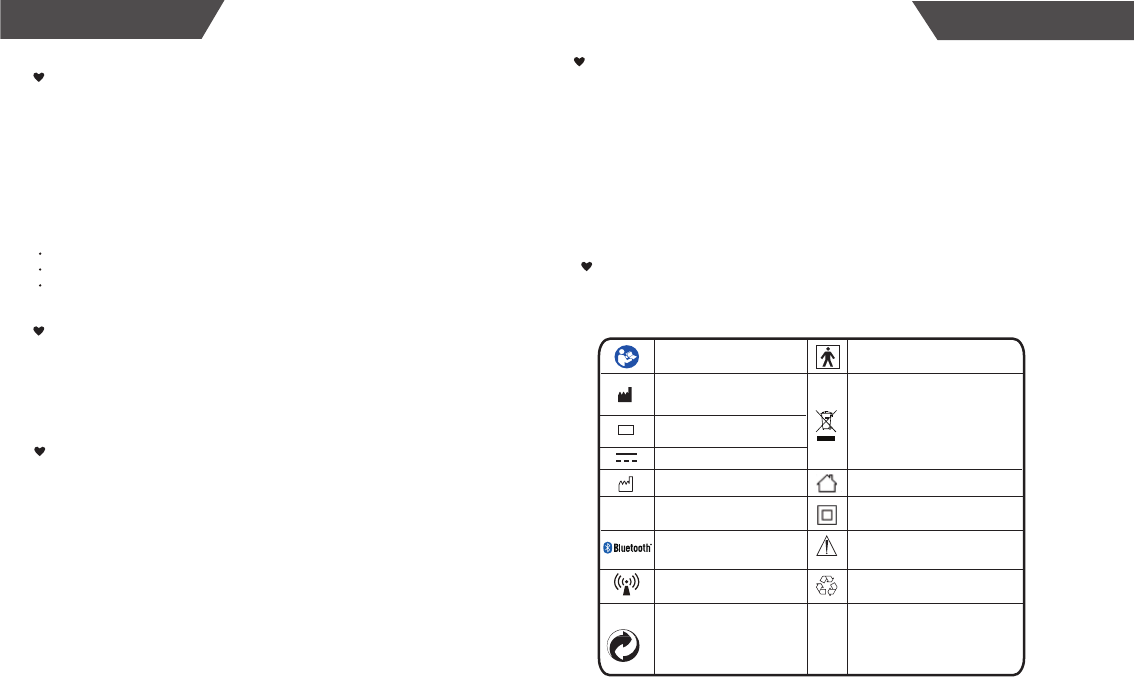
Safety Information
The signs below might be in the user manual, labeling or other component.
They are the requirement of standard and using.
Measurement Principle
This product uses the Oscillometric Measuring method to detect blood pressure.
Before every measurement, the unit establishes a “zero pressure” equivalent to the air
pressure. Then it starts inflating the arm cuff, meanwhile, the unit detects pressure
oscillations generated by beat-to-beat pulsatile, which is used to determine the systolic
and diastolic pressure, and also pulse rate.
The device also compares the longest and the shortest time intervals of detected
pulse waves to mean time interval then calculates standard deviation. The device will
display a warning signal with the reading to indicate the detection of irregular heartbeat
when the difference of the time intervals is over 25%.
Features:
Maximum 60 records per each user
General Description
3rd technonoly: Measuring during inflation
73mm×49 mm Blue LCD display with white backlight
Indications for Use
Thank you for selecting TRANSTEK arm type blood pressure monitor (TMB-995-
BT). The monitor features blood pressure measurement, pulse rate measurement and
the result storage. The design provides you with two years of reliable service.
Readings taken by the TMB-995-BT are equivalent to those obtained by a trained
observer using the cuff and stethoscope auscultation method.
This manual contains important safety and care information, and provides
step by step instructions for using the product.
Read the manual thoroughly before using the product.
The Transtek Blood Pressure Monitor is digital monitors intended for use in measuring
blood pressure and heartbeat rate with arm circumference ranging from 22cm to 42cm
(about 8¾˝-16½˝).
It is intended for adult indoor use only.
Contraindications
This device is contraindicated for any person who is connected to a wearable or
implantable electronic device or instrument, such as a pacemaker or defibrillator.
This blood pressure monitor is not intended to be a diagnostic device.
Contact your physician if hypertensive values are indicated.
Symbol for “THE OPERATION
GUIDE MUST BE READ”
Symbol for “MANUFACTURER”
Symbol for “SERIAL NUMBER”
Symbol for “TYPE BF APPLIED
PARTS”
Symbol for “DIRECT CURRENT”
Symbol for “ENVIRONMENT
PROTECTION - Electrical waste
products should not be disposed of
with household waste. Please recycle
where facilities exist. Check with your
local authority or retailer for recycling
advice”
Symbol for “MANUFACTURE
DATE” For indoor use only
F1
T1A/250V Φ3.6*10CCC Symbol for “Class II Equipment”
Caution: These notes must be
observed to prevent any damage
to the device.
SN
The Bluetooth Combination Mark
Symbol for “Including RF
transmitter”
23
INTRODUCTION INTRODUCTION
The Green Dot is the license
symbol of a European network of
industry-funded systems for
recycling the packaging materials
of consumer goods.
Symbol for “Recycle”

45
INTRODUCTION INTRODUCTION
CAUTION CAUTION
* This device is intended for adult use in homes only.
* The device is not suitable for use on neonatal patients, pregnant women,patients with implanted,
electronical devices, patients with pre-eclampsia, premature ventricular beats, atrial fibrillation, peripheral,
arterial disease and patients undergoing intravascular therapy or arterio-venous shunt or people who
received a mastectomy. Please consult your doctor prior to using the unit if you suffer from illnesses.
* The device is not suitable for measuring the blood pressure of children. Ask your doctor before using it on
older children.
* The device is not intended for patient transport outside a healthcare facility.
* The device is not intended for public use.
* This device is intended for no-invasive measuring and monitoring of arterial blood pressure.
It is not intended for use on extremities other than the arm or for functions other than obtaining a blood
pressure measurement.
* Do not confuse self-monitoring with self-diagnosis. This unit allows you to monitor your blood pressure.Do
not begin or end medical treatment without asking a physician for treatment advice.
* If you are taking medication,consult your physician to determine the most appropriate time to measure your
blood pressure. Never change a prescribed medication without consulting your physician.
* Do not take any therapeutic measures on the basis of a self measurement. Never alter the dose of a
medicine prescribed by a doctor. Consult your doctor if you have any question about your blood pressure.
* When the device was used to measure patients who have common arrhythmias such as atrial or ventricular
premature beats or atrial fibrillation, the best result may occur with deviation. Please consult your physician
about the result.
* Don't kink the connection tube during use, otherwise, the cuff pressure may continuously increase which
can prevent blood flow and result in harmful injury to the PATIENT.
* When using this device, please pay attention to the following situation which may interrupt blood flow and
influence blood circulation of the patient, thus cause harmful injury to the patient: connection tubing kinking
too frequent and consecutive multiple measurements; the application of the cuff and its pressurization on any
arm where intravascular access or therapy, or an arterio-venous (A-V) shunt, is present; inflating the cuff on
the side of a mastectomy.
* Warning: Do not apply the cuff over a wound;otherwise it can cause further injury.
*Do not inflate the cuff on the same limb which other monitoring ME equipment is applied around
simultaneously, because this could cause temporary loss of function of those simultaneously-used monitoring
ME equipment.
*On the rare occasion of a fault causing the cuff to remain fully inflated during measurement, open the cuff
immediately. Prolonged high pressure (cuff pressure > 300mmHg or constant pressure > 15mmHg for more
than 3 minutes) applied to the arm may lead to an ecchymosis.
*Please check that operation of the device does not result in prolonged impairment of patient blood
circulation.
* When measurement, please avoid compression or restriction of the connection tubing.
* The device cannot be used with HF surgical equipment at the same time.
* The ACCOMPANYING DOCUMENT shall disclose that the SPHYGMOMANOMETER was clinically
investigated according to the requirements of ISO 81060-2:2013.
* To verify the calibration of the AUTOMATED SPHYGMOMANOMETER, please contact the manufacturer.
* This device is contraindicated for any female who may be suspected of, or is pregnant. Besides providing
inaccurate readings, the effects of this device on the fetus are unknown.
* Too frequent and consecutive measurements could cause disturbances in blood circulation and injuries.
* This unit is not suitable for continuous monitoring during medical emergencies or operations.Otherwise, the
patient’s arm and fingers will become anaesthetic, swollen and even purple due to a lack of blood.
* When not in use, store the device with the adapter in a dry room and protect it against extreme moisture,
heat, lint, dust and direct sunlight. Never place any heavy objects on the storage case.
* This device may be used only for the purpose described in this booklet. The manufacturer cannot be held
liable for damage caused by incorrect application.
*This device comprises sensitive components and must be treated with caution. Observe the storage and
operating conditions described in this booklet.
* The equipment is not AP/APG equipment and not suitable for use in the presence of a flammable
anesthetic mixture with air of with oxygen or nitrous oxide.
* Warning: No servicing/maintenance while the ME equipment is in use.
* The patient is an intended operator.
* The patient can measure, transmit data and change batteries under normal circumstances and maintain
the device and its accessories according to the user manual.
* To avoid measurement errors, please avoid the condition of strong electromagnetic field radiated
interference signal or electrical fast transient/burst signal.
*The blood pressure monitor, its adaptor, and the cuff are suitable for use within the patient environment.
If you are allergic to polyester, nylon or plastic, please don't use this device.
* During use, the patient will be in contact with the cuff. The materials of the cuff have been tested and
found to comply with requirements of ISO 10993-5:2009 and ISO 10993-10:2010. It will not cause any
potential sensization or irritation reaction.
* Adaptor is specified as a part of ME EQUIPMENT.
* If you experience discomfort during a measurement, such as pain in the arm or other complaints, press
the START/STOP button to release the air immediately from the cuff. Loosen the cuff and remove it from
your arm.
* If the cuff pressure reaches 40 kPa (300 mmHg), the unit will automatically deflate. Should the cuff not
deflate when pressures reaches 40 kPa (300 mmHg), detach the cuff from the arm and press the
START/STOP button to stop inflation.
* Before use, make sure the device functions safely and is in proper working condition. Check the device,
do not use the device if it is damaged in any way. The continuous use of a damaged unit may cause
injury, improper results, or serious danger.
* Do not wash the cuff in a washing machine or dishwasher!
* The service life of the cuff may vary by the frequency of washing, skin condition, and storage state. The
typical service life is 10000 times.
* It is recommended that the performance should be checked every 2 years and after maintenance and
repair, by retesting at least the requirements in limits of the error of the cuff pressure indication and air
leakage (testing at least at 50mmHg and 200mmHg).
* Please dispose of ACCESSORIES, detachable parts, and the ME EQUIPMENT according to the local
guidelines.
* Manufacturer will make available on request circuit diagrams, component part lists, descriptions,
calibration instructions,etc., to assist to service personnel in parts repair.
* The plug/adapter plug pins insulates the device from the main supply. Do not position the device in a
position where it is difficult to disconnect from the supply mains to safely terminate operation of ME
equipment.
* The operator shall not touch output of batteries /adapter and the patient simultaneously.
* Cleaning :Dust environment may affect the performance of the unit. Please use the soft cloth to clean
the whole unit before and after use. Don’t use any abrasive or volatile cleaners.
* The device doesn’t need to be calibrated within two years of reliable service.
* If you have any problems with this device, such as setting up, maintaining or using, please contact the
SERVICE PERSONNEL of Transtek. Don’t open or repair the device by yourself in the event of
malfunctions. The device must only be serviced, repaired and opened by individuals at authorized
sales/service centers.
* Please report to Transtek if any unexpected operation or events occur.
* Keep the unit out of reach of infants, young children or pets to avoid inhalation or swallowing of small
parts. It is dangerous or even fatal.
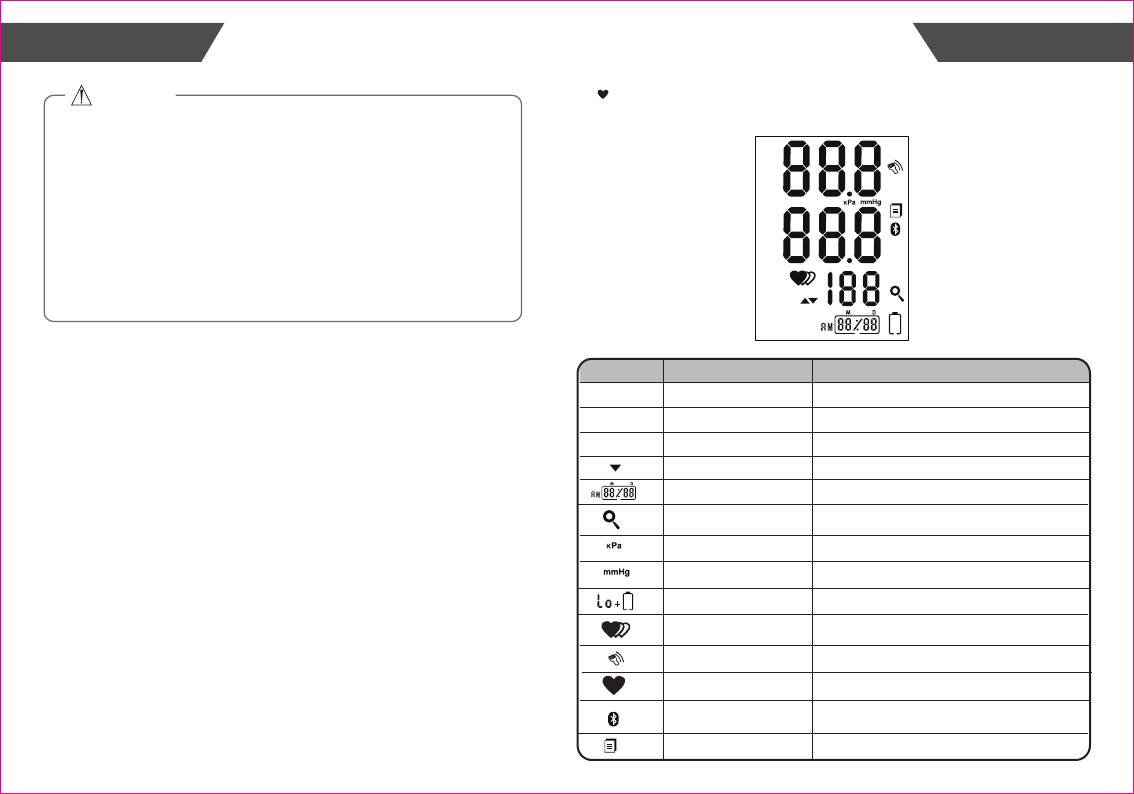
CAUTION
* Be careful to strangulation due to cables and hoses, particularly due to excessive length.
* At least 30 min required for ME equipment to warm from the minimum storage temperature between
uses until it is ready for intended use. At least 30 min required for ME equipment to cool from the
maximum storage temperature between uses until it is ready for intended use.
* This equipment needs to be installed and put into service in accordance with the information provided in
the ACCOMPANYING DOCUMENTS;
* Wireless communications equipment such as wireless home network devices, mobile phones, cordless
telephones and their base stations, walkie-talkies can affect this equipment and should be kept at least a
distance d away from the equipment. The distance d is caculated by the MANUFACTURER from the 800
MHz to 2.5 GHz column of Table 6 of IEC 60601-1-2:2007,as appropriate.
* Please use ACCESSORIES and detachable partes specified/ authorised by MANUFACTURE.
Otherwise, it may cause damage to the unit or danger to the user/patients.
* There is no luer lock connectors are used in the construction of tubing, there is a possibility that they
might be inadvertently connected to intravascular fluid systems, allowing air to be pumped into a blood
vessel.
* Please use the device under the environment which was provided in the user manual. Otherwise, the
performance and lifetime of the device will be impacted and reduced.
67
INTRODUCTION
LCD display signal
INTRODUCTION
SYMBOL DESCRIPTION
Systolic blood pressure High pressure
Diastolic blood pressure Low pressure
EXPLANATION
Pulse Pulse/minute
Deflating CUFF is deflating
Current Time Time(year:month:day:hour:minute)
Memory If “MEM” shows, the displayed measurement
values is from the memory.
mmHg Measurement Unit of the blood pressure
Heartbeat Heartbeat dectetion during measurement
Data pending to transmit Measurement data stored in the equipment
Shocking reminder Shocking will result in inaccurate
Bluetooth icon The bluetooth icon blinks when the
bluetooth is working
Measurement Unit of the blood pressure
(1kPa=7.5mmHg)
kPa
(1mmHg=0.133kPa)
PUL
/min
DIA
mmHg
SYS
mmHg
DIA
SYS
PUL
/min
Low battery Batteries are low and need to be replaced
Blood pressure monitor is detecting an
irregular heartbeat during measurement.
Irregular heartbeat
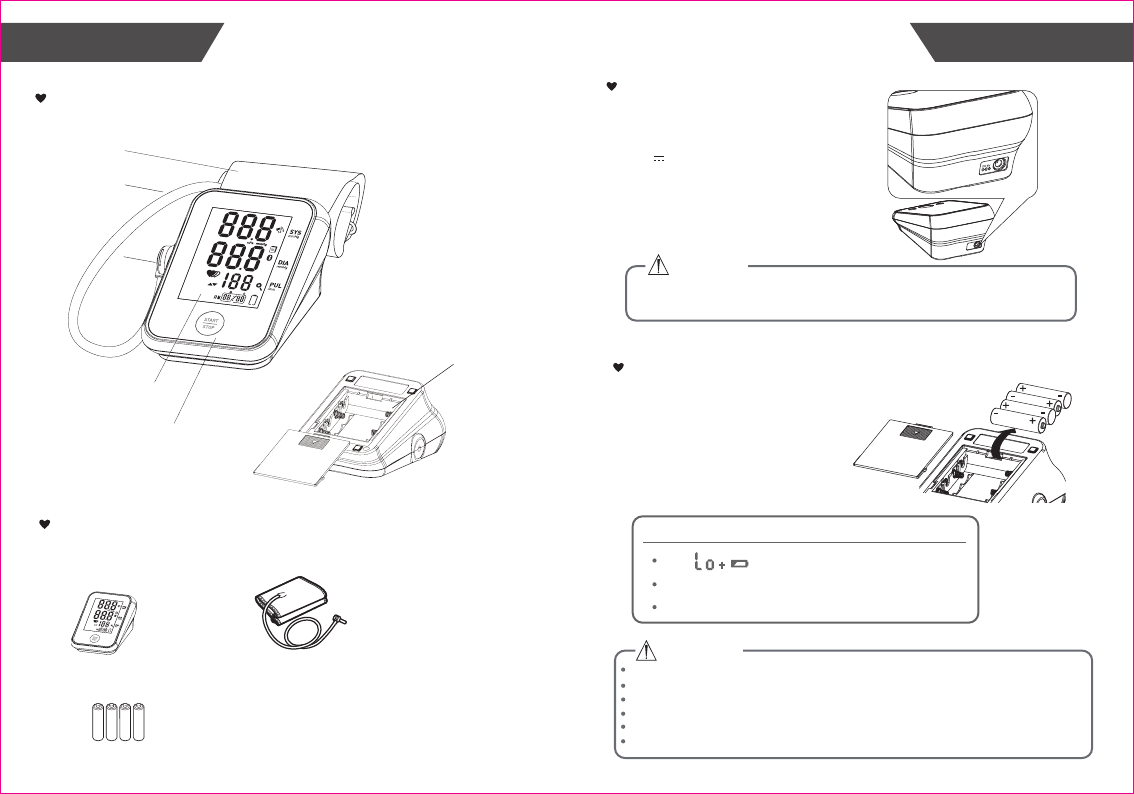
Monitor Components
In order to get the best effect and protect your monitor,please use the right
battery and special power adaptor which complies with US safety standard.
CAUTION
CAUTION
Do not use new and used batteries together.
Do not use different types of batteries together.
Do not dispose the batteries in fire. Batteries may explode or leak.
Remove batteries if the device is not likely to be used for some time.
Worn batteries are harmful to the environment. Do not dispose with daily garbage.
Remove the old batteries from the device following your local recycling guidelines.
List
1.Blood Pressure Monitor
(TMB-995-BT)
4.User manual
2.Cuff (Type BF applied part)
(22cm~42cm)
3. 4×AA batteries
(Please use TRANSTEK
authorized cuff. The size
of the actual cuff please
refer to the label on the
attached cuff.)
Component list of
pressure measuring system
1 Cuff
2 Air pipe
3 PCBA
4 Pump
5 Valve
AIR HOSE
AIR CONNECTOR PLUG
LCD DISPLAY
START/STOP
5. AC Adaptor
(KH0601000UW)
CUFF
The Choice of Power Supply
1.Battery powered mode:
6VDC 4*AA batteries
2.AC adaptor powered mode:
6V 1A
(Can be supplied by AC adaptor model
KH0601000UW !)
Right picture is the hole in for power
adaptor.
BATTERY COMPARTMENT
1.Slide off the battery cover.
2.Install the batteries by matching
the correct polarity, as shown.
3.Replace the cover.
Installing and Replacing the Batteries
Replace the batteries whenever the below happen
The shows
The display dims
The display does not light up
9
8
INTRODUCTION BEFORE YOU START
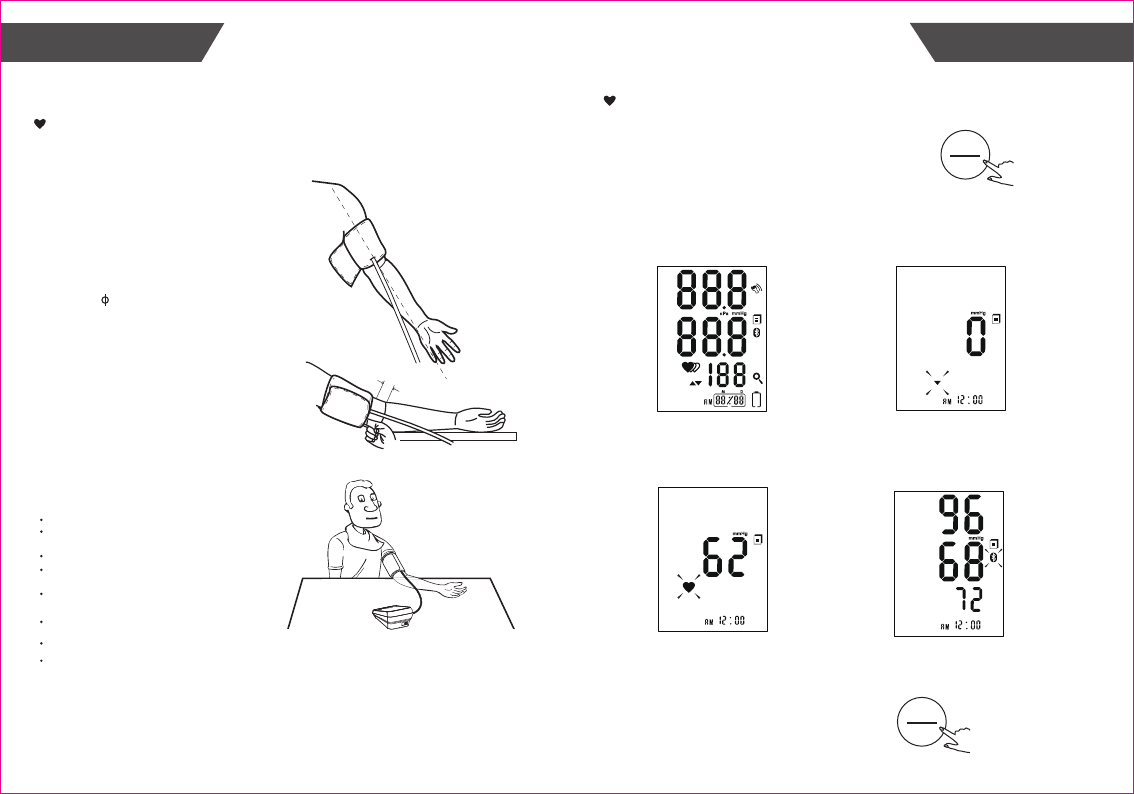
Tie the Cuff
2~3cm
1.
4.
Hold your arm with your palm facing up and
tie the cuff on your upper arm, then position
the tube off-center toward the inner side of
arm in line with the little finger. Or position the
artery mark over the main artery (on the
inside of your arm). Note: Locate the main
artery by pressing with 2 fingers
approximately 2 cm above the bend of your
elbow on the inside of your left arm. Identify
where the pulse can be felt the strongest.
This is your main artery.
The cuff should be snug but not too tight.
You should be able to insert one finger
between the cuff and your arm.
Remove all jewelry, such as watches and
bracelets from your left arm.
Note: If your doctor has diagnosed you with
poor circulation in your left arm, use your right
arm.
Roll or push up your sleeve to expose the
skin. Make sure your sleeve is not too tight.
2.
3.
5. Sit comfortably with your tested arm resting on a
flat surface. Place your elbow on a table so that
the cuff is at the same level as your heart. Turn
your palm upwards. Sit upright in a chair, and take
5-6 deep breaths.
Rest for 5 minutes before first measuring.
Wait at least 3 minutes between measurements.
This allows your blood circulation to recover.
The patient must relax as much as possible and do
not move and talk during the measurement procedure.
For a meaningful comparison, try to measure under
similar conditions. For example, take daily
measurements at approximately the same time, on the
same arm, or as directed by a physician.
6.
Take the measurement in a silent room.
The cuff should maintain at the same level as the
right atrium of the heart.
Please sit comfortably. Do not cross your legs and
keep your feet flat on the ground.
Keep your back against the backrest of the chair.
Helpful tips for Patients, especially for Patients with
Hypertension:
1.When the monitor is off, press
“START/STOP” button to turn it on, it will
finish the whole measurement.
Adjust the zero .
LCD display
Inflating and measuring. Display and save the results. The
data transmission will proceed.
Start the Measurement
2.Press “START/STOP” button to
power off, otherwise it will turn
off within 1 minute.
START
STOP
START
STOP
PUL
/min
DIA
mmHg
SYS
mmHg
PUL
/min
DIA
mmHg
SYS
mmHg
PUL
/min
DIA
mmHg
SYS
mmHg
PUL
/min
DIA
mmHg
SYS
mmHg
11
10
MEASUREMENT
MEASUREMENT
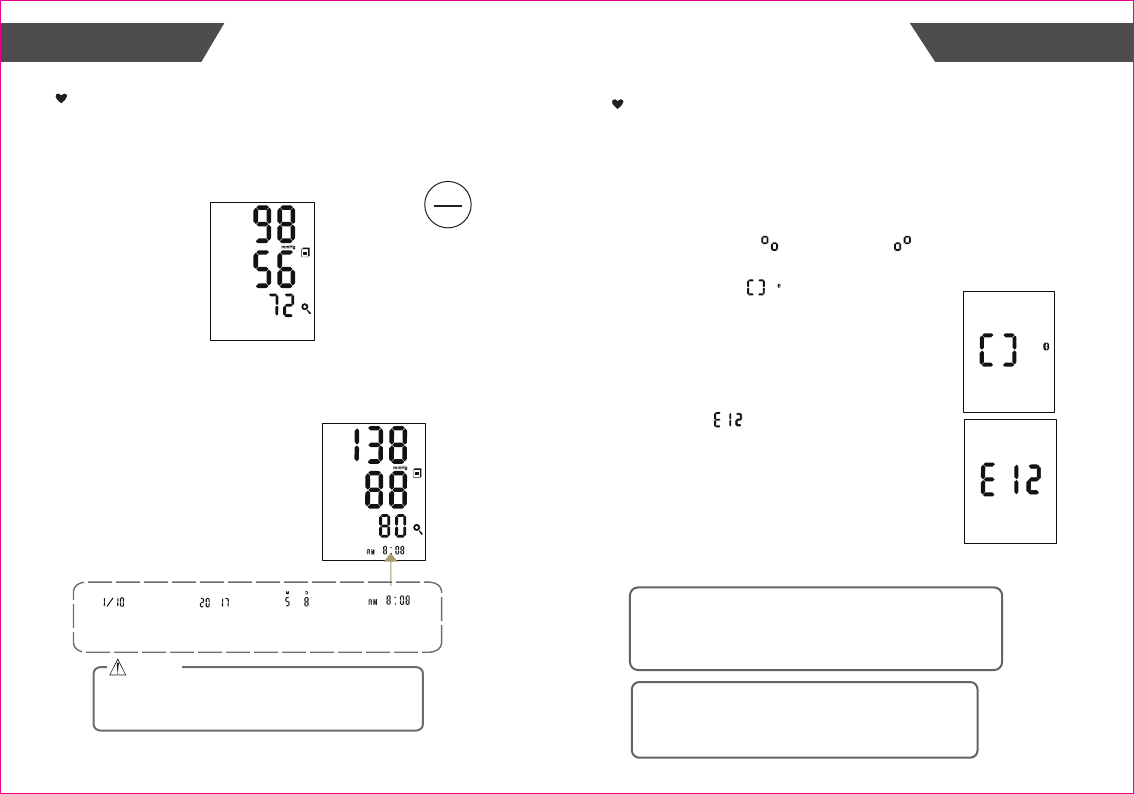
13
12
DATA MANAGEMENT DATA MANAGEMENT
Recall the records
PUL
/min
DIA
mmHg
SYS
mmHg
START
STOP
1.When the monitor is off, press and hold the “ START/STOP ”
button to enter bluetooth pair-up mode. Press and hold “
START/STOP ” button again to enter query mode, the monitor
will show the average value of the latest three records.
PUL
/min
DIA
mmHg
SYS
mmHg
2.Press “ START/STOP ” button again to get the record you want.
During the process of displaying the results, if there is no operation,
the blood pressure montior will turn off in one minute. Or you can hold
and press “ START/STOP ” button to turn it off.
The record number will
display once, year,date
and time will display
many times alternately.
It means the total
records are 10, the
current No. is No. 1.
The corresponding
time is AM 8:08.
The corresponding
date is May 8 .
th
The corresponding
year is 2017.
The most recent record (1) is shown first. Each new measurement
is assigned to the first (1) record. All other records are pushed
one digit (e.g., 2 becomes 3, and so on), and the last record (60)
CAUTION
Pair up the Blood Pressure Monitor
with Your Device
1.Turn on Bluetooth and the app. Make sure both are on when pair-up is
proceeding.
2.When the monitor is off, press and hold the START/STOP button to start
pair-up. The symbol and the symbol will be shown on the
LCD alternatively, indicating pair-up is proceeding.
5.The monitor will shut off automatically after pair-up process is complete.
Bluetooth Module No.: AW8001
RF Frequency Range: 2402 MHz to 2480 MHz
Output Power Range:
≤0 dBm
Supply Voltage: 1.8-3.6 V
Transmitting Distance: 10 meters
List of compatible devices:
For iOS devices:
The operating system must be iOS 8 or more, such as iPhone
4S, iPhone 5/5C/5S, iPhone 6/6 Plus and so on.
For Android devices:
The operating system must be 4.3 or more.
3.If succeed, symbol will be shown on the LCD.
4.If fail, symbol will be shown on the LCD.
PUL
/min
DIA
mmHg
SYS
mmHg
PUL
/min
DIA
mmHg
SYS
mmHg
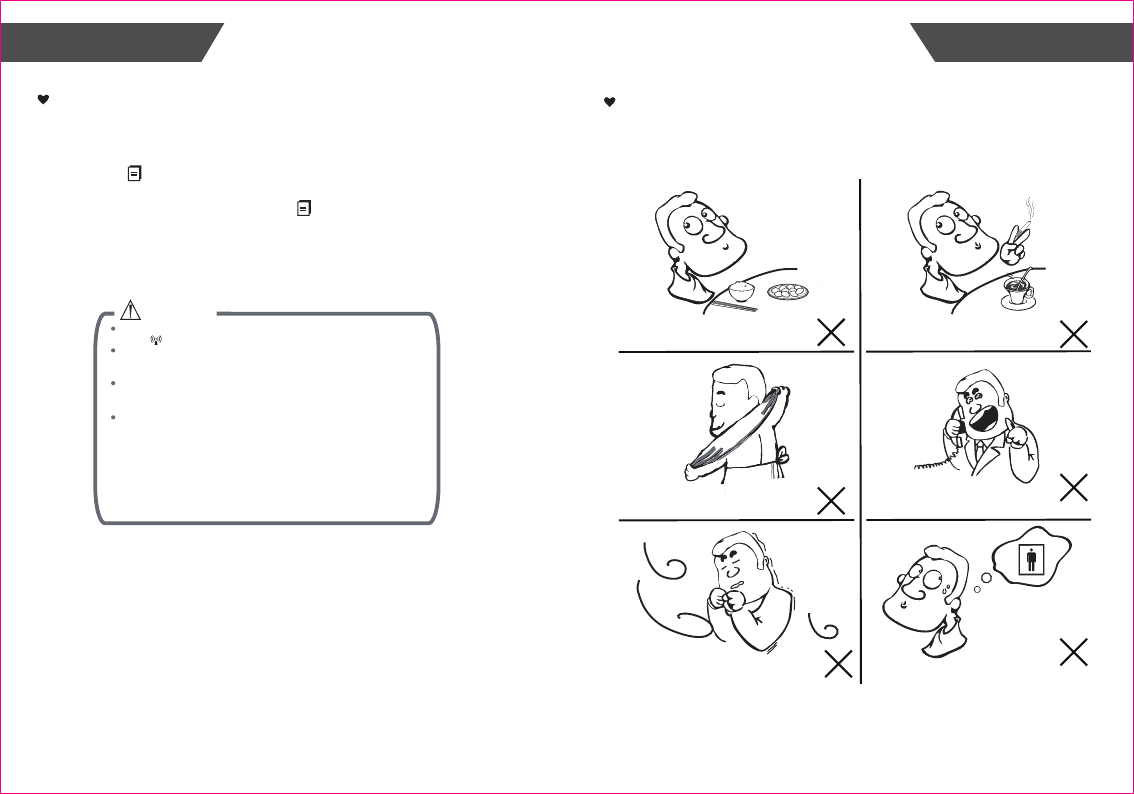
1.With TMB-995-BT successfully pair-up, the measurement data will be
automatically transmitted to your mobile device via Bluetooth.
2.The symbol will disappear after successful data transmission, and you may
check your personal health data stored in your mobile device.
3.If the data transmission fails, the symbol will remain. The pending
measurement data will be transmitted to your mobile device when next
measurement is complete.
Data Transmission
CAUTION
1.
2.
Interference may occur in the vicinity of equipment marked with the following
symbol . And TMB-995-BT may interfering vicinity electrical equipment.
Sensitive people, including pregnant women pre-eclamptic and those who
implanted medical electronic instruments, should avoid using the unit
whenever possible.
Keep the monitor at least 20 centimeters away from the human body
(especially the head) when the data transmission is proceeding after
measurement.
To enable the data transmission function, this product should be paired to
Bluetooth end at 2.4 GHz.
How to mitigate possible interference?
The range between the device and BT end should be reasonably close, from
1 meter to 10 meters. Please ensure no obstacles between the device and
BT end so as to obtain quality connection and to lower the RF output range.
To avoid interference, other electronic devices (particularly those with
wireless transmission / Transmitter) should be kept at least 1 meter away
from the monitor.
15
14
DATA MANAGEMENT
Tips for Measurement
Measurements may be inaccurate if taken in the following
circumstances.
Within 1 hour
after dinner or drinking
Within 20 minutes
after taking a bath
In a very cold environment
Immediate measurement
after tea, coffe, smoking
When talking or moving your fingers
When you want to discharge urine
INFORMATION FOR USER
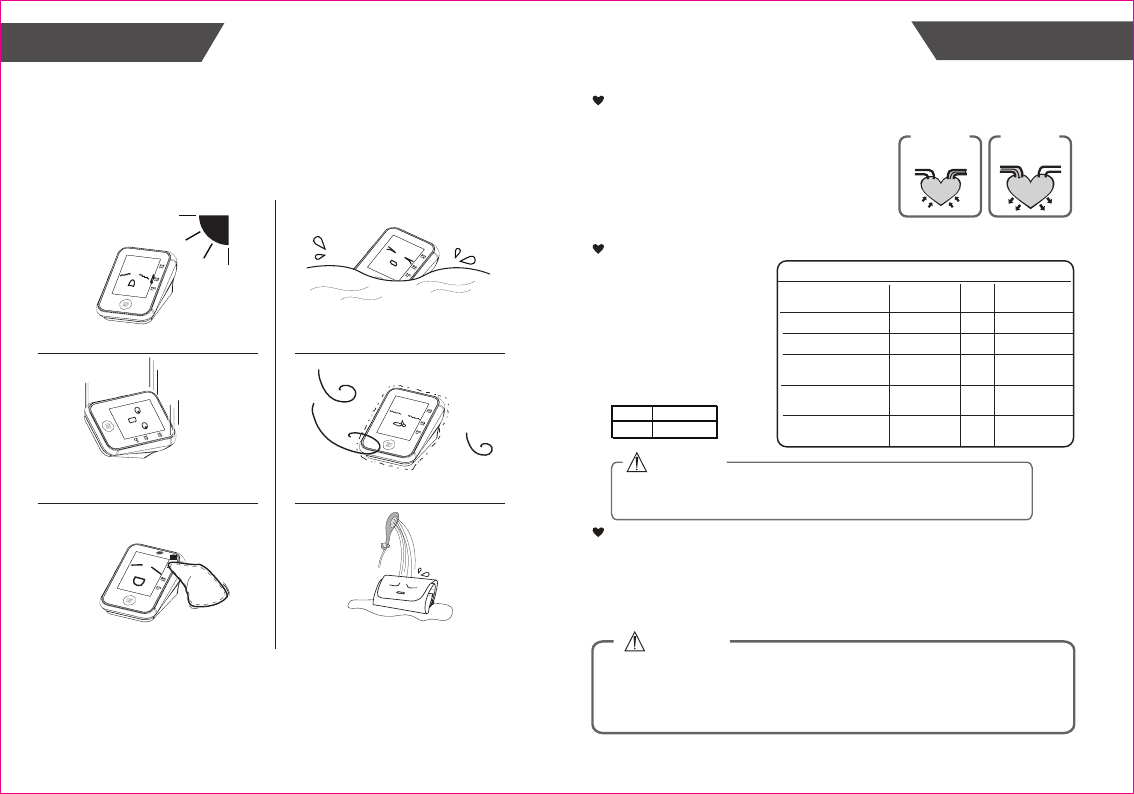
17
16
INFORMATION FOR USER
Maintenance
In order to get the best performance, please follow the instructions
below.
Put in a dry place and avoid the sunshine
Avoid intense shaking
and collisions
Using wet cloths to remove dirt
Avoid touching water,
clean it with a dry cloth in case.
Avoid dusty and unstable
temperature environment
Avoid washing the cuff
What are systolic pressure and diastolic pressure?
press
artery vein
blood discharging
Systolic
relax
blood entering
Diastolic
When ventricles contract and pump blood out
of the heart, the blood pressure reaches its
maximum value in the cycle, which is called
systolic pressure. When the ventricles relax,
the blood pressure reaches its minimum value
in the cycle, which is called diastolic pressure.
What is the standard blood pressure classification?
Irregular Heartbeat Detector
CAUTION
The appearance of the IHB icon indicates that a pulse irregularity consistent with an
irregular heartbeat was detected during measurement. Usually this is NOT a cause for
concern. However, if the symbol appears often, we recommend you seek medical advice.
Please note that the device does not replace a cardiac examination, but serves to detect
pulse irregularities at an early stage.
Only a physician can tell your normal BP range. Please contact a physician if
your measuring result falls out of the range. Please note that only a physician
can tell whether your blood pressure value has reached a dangerous point.
The chart on the right is the
standard blood pressure
classification published by
American Heart
Association (AHA).
CAUTION
Blood Pressure Category
Normal
Prehypertension
High Blood Pressure
(Hypertension) Stage 1
High Blood Pressure
(Hypertension) Stage 2
Hypertensive Crisis
(Emergency care needed)
Systolic
mmHg (upper#)
Diastolic
mmHg (lower#)
less than 120
120-139
140-159
160 or higher
Higher than 180
and
or
or
or
or
less than 80
80-89
90-99
100 or higher
Higher than 110
This chart reflects blood pressure categories defined by American Heart Association.
AHA Home Guideline for
Upper Limit of Normal BP
SYS 135 mm Hg
DIA 85 mm Hg
An irregular heartbeat is detected when a heartbeat rhythm varies while the unit is
measuring the systolic and diastolic blood pressure.During each measurement,
this equipment records the heartbeat intervals and works out the standard deviation.
If the calculated value is larger than or equal to 25%,the irregular heartbeat symbol
appears on the symbol when the measurement results are displayed.
ABOUT BLOOD PRESSURE
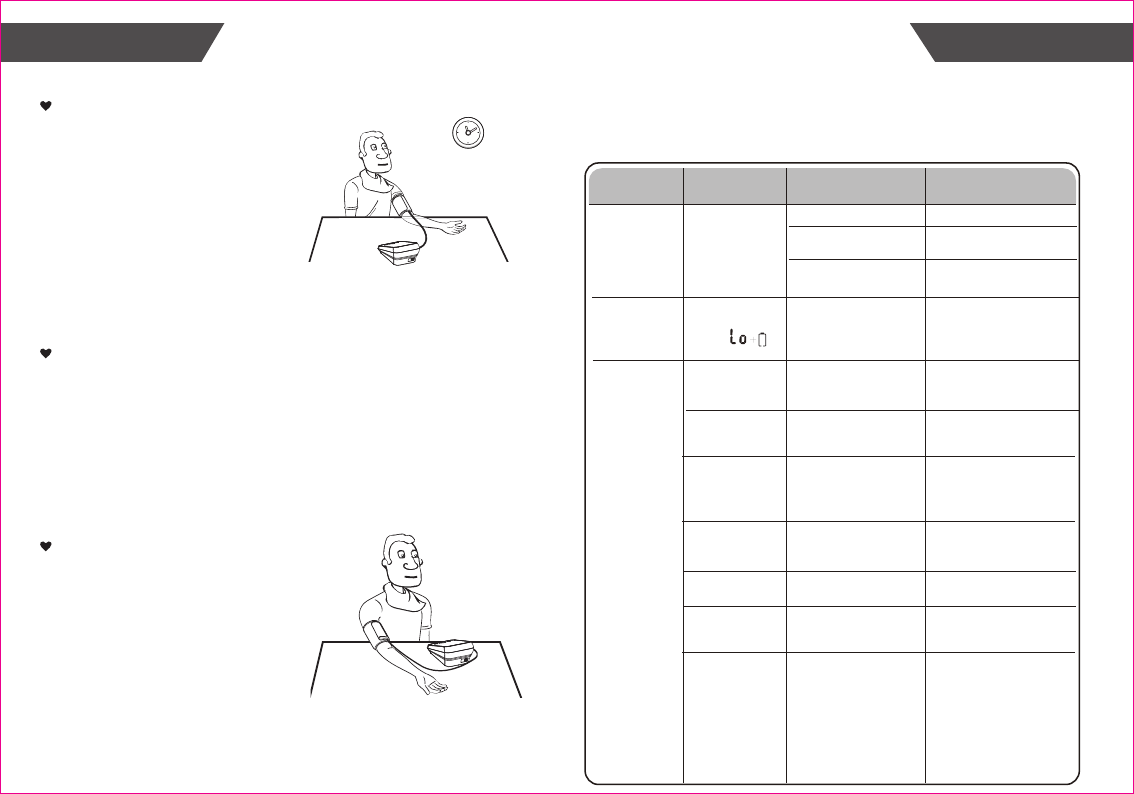
19
18
ABOUT BLOOD PRESSURE
Why does my blood
pressure fluctuate
throughout the day?
Is the result the same if
measuring on the right
arm?
Why do I get a different
blood pressure at home
compared to the hospital?
1. Individual blood pressure varies
multiple times everyday. It is also affected
by the way you tie your cuff and your
measurement position, so please take the
measurement under the same conditions.
2.If the person takes medicine, the
pressure will vary more.
3.Wait at least 3 minutes for another
measurement.
The blood pressure is different even
throughout the day due to weather,
emotion, exercise etc, Also, there is the
“white coat” effect, which means blood
pressure usually increases in clinical
settings.
It is ok for both arms, but there
will be some different results for
different people. We suggest you
measure the same arm every time.
What you need to pay
attention to when you measure
your blood pressure at home:
If the cuff is tied properly.
If the cuff is too tight or too loose.
If the cuff is tied on the upper arm.
If you feel anxious.
Taking 2-3 deep breaths before
beginning will be better for measuring.
Advice: Relax yourself for 4-5
minutes until you calm down.
This section includes a list of error messages and frequently
asked questions for problems you may encounter with your blood
pressure monitor. If the products not operating as you think it
should, check here before arranging for servicing.
TROUBLESHOOTING
PROBLEM SYMPTOM CHECK THIS REMEDY
No power
Low
batteries
Error
message
Display
will not light up.
Batteries are exhausted. Replace with new batteries
Insert the batteries
correctly
Replace with new batteries
Batteries are inserted
incorrectly.
Batteries are low.
Check if the APP is on,
operate and send the data
again.
E01 shows The cuff is not secure.
Readjust the cuff and
relax for a moment
and then measure again.
E02 shows
Movement can affect the
measurement.Relax for a
moment and then
measure again.
E03 shows
The measurement
process does not detect
the pulse signal.
Loosen the clothing on the
arm and then measure
again
EExx,shows on
the display.
A calibration error
occurred.
Retake the measurement.
If the problem persists,
contact the retailer or our
customer service
department for further
assistance.Refer to the
warranty for contact
information and return
instructions.
E04 shows The treatment of the
measurement failed.
Relax for a moment and
then measure again.
Display is dim or
shows
The monitor detected
motion,talking or the
pluse is too poor
while measuring.
AC adaptor is inserted
incorrectly.
Insert the AC adaptor
tightly
E12 shows Communication error
out The results are over the
measurement range
Remeasurement, according
to the user manual
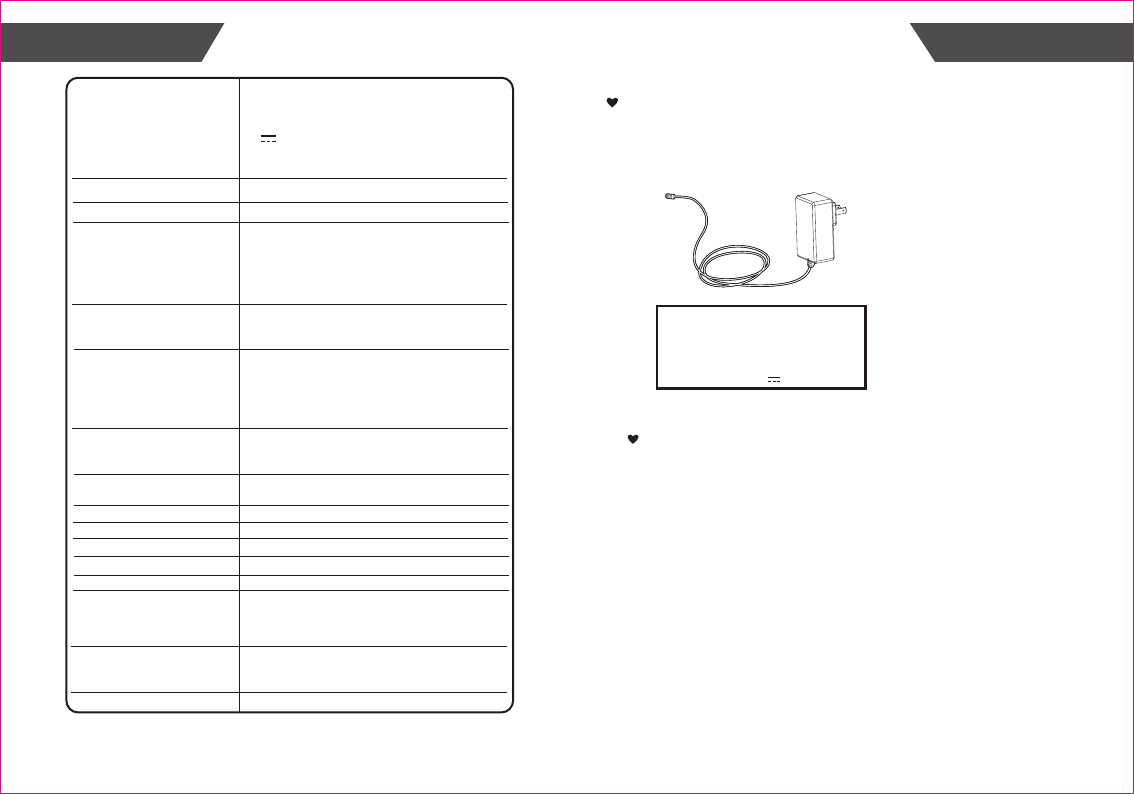
21
20
SPECIFICATIONS
Battery powered mode:
6VDC 4*AA batteries
AC adaptor powered mode:
6V 1A
(Can be supplied by AC adaptor model
KH0601000UW !)
Blue LCD with white backlight V.A.60mm*80mm
Approx.260g(Excluding the dry cells)
Approx.102mm*143mm*73mm
4*AA batteries, AC adaptor, user manual
A01
About 22cm~42cm
Type BF applied part
WARNING: No modification of this equipment is allowed.
Power supply
Display mode
Measurement mode Oscillographic testing mode
Measurement range
Measurement perimeter
of the upper arm
Weight
External dimensions
Attachment
Mode of operation Continuous operation
Degree of protection
Protection against
ingress of water
Accuracy
Normal working condition
Storage & transportation
condition
Software Version
Rated cuff pressure:
0mmHg~299mmHg(0kPa ~ 39.9kPa)
Measurement pressure:
SYS: 60mmHg~230mmHg (8.0kPa~30.7kPa)
DIA: 40mmHg~130mmHg (5.3kPa~17.3kPa)
Pulse value: (40-199)beat/minute
Device Classification Battery Powered Mode:
Internally Powered ME Equipment
AC Adaptor Powered Mode: Class II ME Equipment
IP21 It means the device could protected against
solid foreign objects of 12.5mm and greater, and
protect against vertically falling water drops.
Pressure:
5℃-40℃ within±3mmHg(0.4kPa)
pulse value:±5%
A temperature range of :+5°C to +40°C
A relative humidity range of 15% to 90%,
non-condensing, but not requiring a water vapour
partial pressure greater than 50 hPa
An atmospheric pressure range of :
700 hPa to 1060 hPa
Temperature:-20°C to +60°C
A relative humidity range of ≤ 93%, non-condensing,
at a water vapour pressure up to 50hPa
Authorized Component
1.please use the TRANSTEK
authorized adapter.
Adapter
Type:KH0601000UW
Input:100~240V~
50/60Hz, 0.4A Max
Output:6V 1000mA
Contact Information
For more information about our products, please visit www.transtek.cn.you can get
customer service, usual problems and customer download, transtek will serve you
anytime.
Manufactured by:
Company:
Address:
Guangdong Transtek Medical Electronics Co., Ltd.
Zone A, No.105 ,Dongli Road, Torch Development District,
Zhongshan,528437,Guangdong,China
Guangdong Transtek Medical Electronics Co., Ltd.
AUTHORIZED COMPONENT
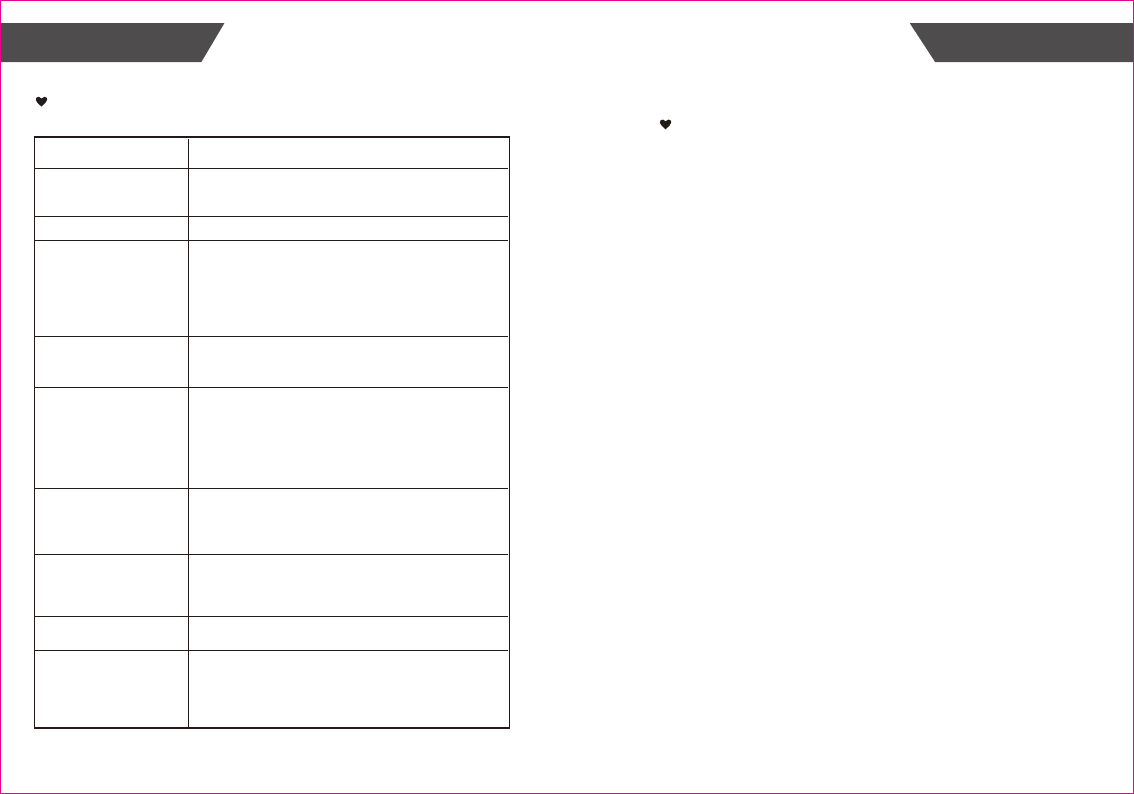
Complied Standards List
EN ISO 14971:2012 / ISO 14971:2007 Medical devices - Application
of risk management to medical devices
EN 980:2008 Symbols for use in the labelling of medical devices
EN 1041:2008 Information supplied by the manufacturer of medical
devices
EN 60601-1:2006/ IEC 60601-1:2005+A1:2012 Medical electrical
equipment - Part 1: General requirements for basic safety and essential
performance
EN 60601-1-11:2010/ IEC 60601-1-11:2015 Medical electrical
equipment - Part 1-11: General requirements for basic safety and
essential performance - Collateral standard: Requirements for medical
electrical equipment and medical electrical systems used in the home
healthcare environment
EN ISO 81060-1:2012 Non-invasive sphygmomanometers - Part 1:
Requirements and test methods for non-automated measurement type
EN 1060-3:1997+A2:2009 Non-invasive sphygmomanometers - Part
3: Supplementary requirements for electro-mechanical blood pressure
measuring systems
EN 1060-4:2004 Non-invasive sphygmomanometers - Part 4: Test
procedures to determine the overall system accuracy of automated
non-invasive sphygmomanometers
EN 60601-1-6:2010/IEC 60601-1-6:2010+A1:2013 Medical electrical
equipment - Part 1-6: General requirements for basic safety and
essential performance - Collateral standard: Usability
EN 62366:2008/ IEC 62366-1:2015 Medical devices - Application of
usability engineering to medical devices
EN 62304:2006/AC: 2008 / IEC 62304:2006 Medical device
software - Software life-cycle processes
Risk management
Labeling
User manual
General Requirements
for Safety
Electromagnetic
compatibility
Performance
requirements
Clinical investigation
Usability
Software life-cycle
processes
Bio-compatibility
ISO 10993-1:2009 Biological evaluation of medical devices- Part
1: Evaluation and testing within a risk management process
ISO 10993-5:2009 Biological evaluation of medical devices - Part
5: Tests for in vitro cytotoxicity
ISO 10993-10:2010 Biological evaluation of medical devices -
Part 10: Tests for irritation and skin sensitization
ISO 15223-1:2012 Medical devices. Symbols to be used with
medical device labels, labelling and information to be supplied. Part 1
: General requirements
IEC 80601-2-30:2013 Medical electrical equipment- Part 2-30:
Particular requirements for the basic safety and essential
performance of automated non-invasive sphygmomanometers
ISO 81060-2:2013 Non-invasive sphygmomanometers - Part 2:
Clinical validation of automated measurement type
EN 60601-1-2:2007/ IEC 60601-1-2:2007 Medical electrical
equipment - Part 1-2: General requirements for basic safety and
essential performance - Collateral standard: Electromagnetic
compatibility - Requirements and tests
23
22
COMPLIED STANDARDS LIST
FCC Statement
This device complies with Part 15 of the FCC Rules. Operation is
subject to the following two conditions: (1) this device may not cause
harmful interference, and (2) this device must accept any interference
received, including interference that may cause undesired operation.
Caution: The user is cautioned that changes or modifications not
expressly approved by the party responsible for compliance could void
the user's authority to operate the equipment.
NOTE: This equipment has been tested and found to comply with
the limits for a Class B digital device, pursuant to Part 15 of the FCC
Rules. These limits are designed to provide reasonable protection
against harmful interference in a residential installation. This equipment
generates, uses and can radiate radio frequency energy and, if not
installed and used in accordance with the instructions, may cause
harmful interference to radio communications. However, there is no
guarantee that interference will not occur in a particular installation.
If this equipment does cause harmful interference to radio or
television reception, which can be determined by turning the equipment
off and on,the user is encouraged to try to correct the interference by
one or more of the following measures:
-- Reorient or relocate the receiving antenna.
-- Increase the separation between the equipment and receiver.
-- Connect the equipment into an outlet on a circuit different from that
to which the receiver is connected.
-- Consult the dealer or an experienced radio/TV technician for help.
FCC Radiation Exposure Statement:
This equipment complies with FCC radiation exposure limits set forth
for an uncontrolled environment.
This transmitter must not be co-located or operating in conjunction
with any other antenna or transmitter.
FCC ID: OU9TMB995-BT
FCC STATEMENT
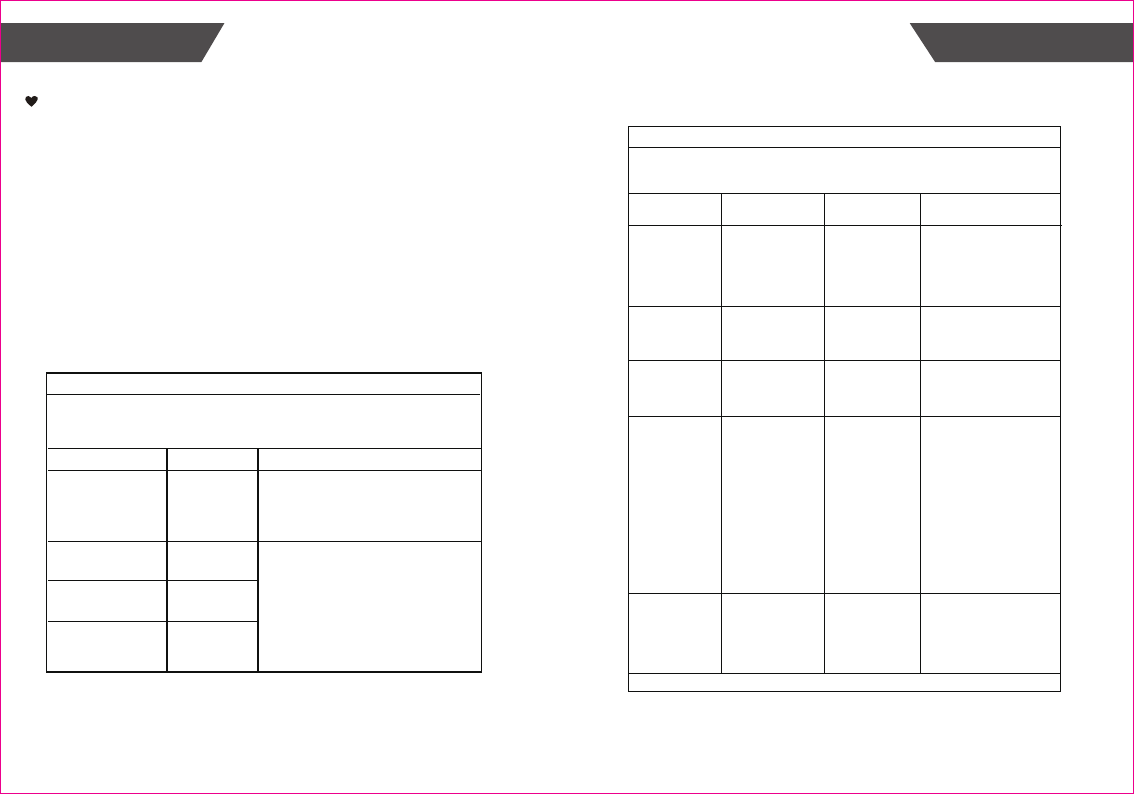
24 25
EMC GUIDANCE
EMC Guidance
Table 1 Guidance and MANUFACTURER’s declaration – ELECTROMAGNETIC
EMISSIONS- for all ME EQUIPMENT and ME SYSTEMS
Guidance and manufacturer’s declaration – electromagnetic emissions
RF emissions
CISPR 11 Group 1
Class B
Not applicable
Not applicable
Compliance
The device is intended for use in the electromagnetic environment specified
below. The customer or the user of the device should assure that it is used in
such an environment.
Harmonic emissions
IEC 61000-3-2
Voltage fluctuations/
flicker emissions IEC
61000-3-3
RF emissions
CISPR 11
Emissions test Electromagnetic environment - guidance
The device uses RF energy only for its
internal function. Therefore, its RF
emissions are very low and are not likely
to cause any interference in nearby
electronic equipment.
The device is suitable for use in all establishments,
including domestic establishments and those directly
connected to the public low-voltage power supply
network that supplies buildings used for domestic
purposes.
1)This product needs special precautions regarding EMC and needs to be installed and put
into service according to the EMC information provided,
and this unit can be affected by portable and mobile RF communications equipment.
2)* Do not use a mobile phone or other devices that emit electromagnetic fields, near the unit.
This may result in incorrect operation of the unit.
3)Caution: This unit has been thoroughly tested and inspected to assure proper performance
and operation!
4)* Caution: this machine should not be used adjacent to or stacked with other equipment and
that if adjacent or stacked use is necessary, this machine should be observed to verify normal
operation in the configuration in which it will be used.
Guidance and manufacturer’s declaration – electromagnetic immunity
IMMUNITY test
±6 kV contact
±8 kV air ±6 kV contact
±8 kV air
±2 kV for
power supply lines
<5% U
T
(>95% dip in U
T
)
for 0.5 cycle
40% U
T
(60% dip in U
T
)
for 5 cycles
70% U
T
(30% dip in U
T
)
for 25 cycles
<5% U
T
(>95% dip in U
T
)
for 5 sec
3A/m
NOTE U
T
is the a.c. mains voltage prior to application of the test level.
Table 2 Guidance and MANUFACTURER’s declaration – electromagnetic
IMMUNITY – for all ME EQUIPMENT and ME SYSTEMS
IEC 60601 test level Compliance level
Electrostatic
discharge (ESD)
IEC 61000-4-2
Electromagnetic
environment - guidance
Floors should be wood,
concrete or ceramic tile. If
floors are covered with
synthetic material, the
relative humidity should be
at least 30%.
Power frequency magnetic
fields should be at levels
characteristic of a typical
location in a typical
commercial or hospital
environment.
3A/m
Power frequency
(50Hz/60Hz)
magnetic field
IEC 61000-4-8
Voltage dips,
short interruptions
and voltage
variations on
power supply
input lines
IEC 61000-4-11
Electrical fast
transient/burst
IEC 61000-4-4
Surge IEC
61000-4-5
The device is intended for use in the electromagnetic environment specified below.
The customer or the user of the device should assure that it is used in such an
environment
Mains power quality should
be that of a typical
commercial or hospital
environment.
Mains power quality should
be that of a typical
commercial or hospital
environment.
Mains power quality should
be that of a typical
commercial or hospital
environment. If the user of
the device requires
continued operation during
power mains interruptions,
it is recommended that the
device be powered from an
uninterruptible power supply
or a battery.
±2 kV for power
supply lines
±1 kV differential
mode
<5% U
T
(>95% dip in U
T
)
for 0.5 cycle
40% U
T
(60% dip in U
T
)
for 5 cycles
70% U
T
(30% dip in U
T
)
for 25 cycles
<5% U
T
(>95% dip in U
T
)
for 5 sec
EMC GUIDANCE
±1 kV differential
mode
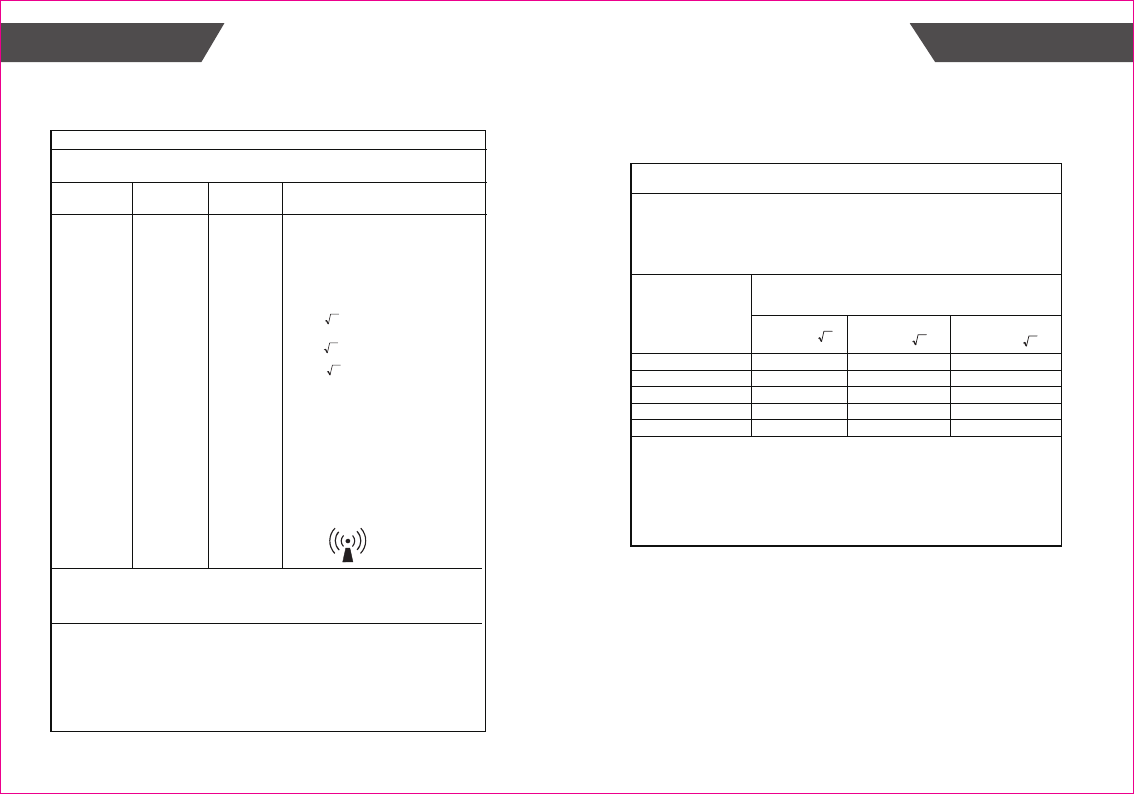
Table 4 Guidance and MANUFACTURER’s declaration – electromagnetic IMMUNITY –
for ME EQUIPMENT and ME SYSTEMS that are not LIFE-SUPPORTING
Guidance and manufacturer’s declaration – electromagnetic immunity
IMMUNITY test
3 Vrms
3 V/m
Compliance
level
IEC 60601
TEST LEVEL
Conducted RF
IEC 61000-4-6
Radiated RF
IEC 61000-4-3
3 V/m
80 MHz to
2.5 GHz
3 Vrms
150 kHz to
80 MHz
Electromagnetic environment -
guidance
Portable and mobile RF communications
equipment should be used no closer to
any part of the device, including
cables, than the recommended
separation distance calculated from the
equation applicable to the frequency of
the transmitter.
Recommended separation distance
The device is intended for use in the electromagnetic environment specified below.
The customer or the user of the device should assure that it is used in such an environment.
where P is the maximum output power
rating of the transmitter in watts (W)
according to the transmitter manufacturer
and d is the recommended separation
distance in metres (m).
Field strengths from fixed RF
transmitters, as determined by an
electromagnetic site survey, should be
less than the compliance level in each
frequency range.
b
Interference may occur in the vicinity of
equipment marked with the following
symbol:
P
=d
P=d
80 MHz to 800 MH
P=d 2.3
800 MHz to 2,5 G
1.2
NOTE 1 At 80 MHz and 800 MHz, the higher frequency range applies.
NOTE 2 These guidelines may not apply in all situations. Electromagnetic
propagation is affected by absorption and reflection from structures, objects
and people.
a
Field strengths from fixed transmitters, such as base stations for radio (cellular /
cordless) telephones and land mobile radios, amateur radio, AM and FM radio broad-
cast and TV broadcast cannot be predicted theoretically with accuracy. To assess the
electromagnetic environment due to fixed RF transmitters, an electromagnetic site
survey should be considered. If the measured field strength in the location in which
the device is used exceeds the applicable RF compliance level above, the device
should be observed to verify normal operation. If abnormal performance is observed,
additional measures may be necessary, such as re-orienting or relocating the device.
Over the frequency range 150 kHz to 80 MHz, field strengths should be less than 3V/m.
b
1.2
150 kHz to 80 MHz 80 MHz to 800 MHz 800 MHz to 2.5 GHz
Table 6 Recommended separation distances between portable and mobile
RF communications equipment and the ME EQUIPMENT or ME SYSTEM –
for ME EQUIPMENT and ME SYSTEMS that are not LIFE-SUPPORTING
Recommended separation distances
between portable and mobile RF communications equipment and the device.
The device is intended for use in an electromagnetic environment in which
radiated RF disturbances are controlled. The customer or the user of the device
can help prevent electromagnetic interference by maintaining a minimum distance
between portable and mobile RF communications equipment (transmittters) and the
device as recommended below, according to the maximum output power of the
communications equipment.
Rated maximum output
power of transmitter
(W)
Separation distance according to frequency of transmitter (m)
For transmitters rated at a maximum output power not listed above, the recommended
separation distance d in metres (m) can be estimated using the equation applicable to
the frequency of the transmitter, where P is the maximum output power rating of the
transmitter in watts (W) according to the transmitter manufacturer.
NOTE 1 At 80MHz and 800MHz, the separation distance for the higher frequency
range applies.
NOTE 2 These guidelines may not apply in all situations. Electromagnetic propagation
is affected by absorption and reflection from structures, objects and people.
0.01
0.1
1
10
100
0.12 0.12
0.38
1.2
3.8
12
0.23
0.73
2.3
7.3
23
P=d P=d 1.2 2.3 P=d
0.38
1.2
3.8
12
1.2
26 27
EMC GUIDANCEEMC GUIDANCE